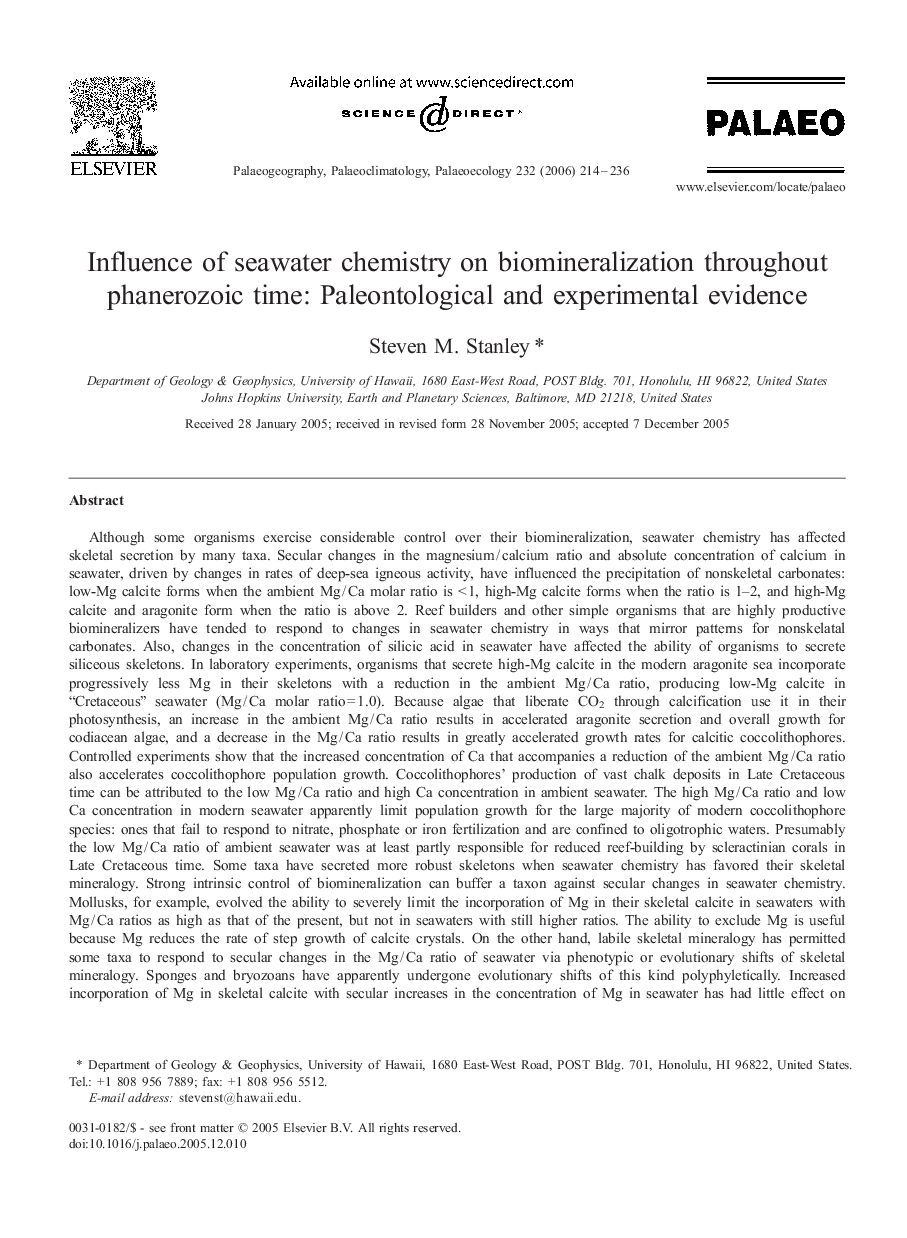| کد مقاله | کد نشریه | سال انتشار | مقاله انگلیسی | نسخه تمام متن |
|---|---|---|---|---|
| 4469602 | 1622377 | 2006 | 23 صفحه PDF | دانلود رایگان |

Although some organisms exercise considerable control over their biomineralization, seawater chemistry has affected skeletal secretion by many taxa. Secular changes in the magnesium / calcium ratio and absolute concentration of calcium in seawater, driven by changes in rates of deep-sea igneous activity, have influenced the precipitation of nonskeletal carbonates: low-Mg calcite forms when the ambient Mg / Ca molar ratio is < 1, high-Mg calcite forms when the ratio is 1–2, and high-Mg calcite and aragonite form when the ratio is above 2. Reef builders and other simple organisms that are highly productive biomineralizers have tended to respond to changes in seawater chemistry in ways that mirror patterns for nonskelatal carbonates. Also, changes in the concentration of silicic acid in seawater have affected the ability of organisms to secrete siliceous skeletons. In laboratory experiments, organisms that secrete high-Mg calcite in the modern aragonite sea incorporate progressively less Mg in their skeletons with a reduction in the ambient Mg / Ca ratio, producing low-Mg calcite in “Cretaceous” seawater (Mg / Ca molar ratio = 1.0). Because algae that liberate CO2 through calcification use it in their photosynthesis, an increase in the ambient Mg / Ca ratio results in accelerated aragonite secretion and overall growth for codiacean algae, and a decrease in the Mg / Ca ratio results in greatly accelerated growth rates for calcitic coccolithophores. Controlled experiments show that the increased concentration of Ca that accompanies a reduction of the ambient Mg / Ca ratio also accelerates coccolithophore population growth. Coccolithophores' production of vast chalk deposits in Late Cretaceous time can be attributed to the low Mg / Ca ratio and high Ca concentration in ambient seawater. The high Mg / Ca ratio and low Ca concentration in modern seawater apparently limit population growth for the large majority of modern coccolithophore species: ones that fail to respond to nitrate, phosphate or iron fertilization and are confined to oligotrophic waters. Presumably the low Mg / Ca ratio of ambient seawater was at least partly responsible for reduced reef-building by scleractinian corals in Late Cretaceous time. Some taxa have secreted more robust skeletons when seawater chemistry has favored their skeletal mineralogy. Strong intrinsic control of biomineralization can buffer a taxon against secular changes in seawater chemistry. Mollusks, for example, evolved the ability to severely limit the incorporation of Mg in their skeletal calcite in seawaters with Mg / Ca ratios as high as that of the present, but not in seawaters with still higher ratios. The ability to exclude Mg is useful because Mg reduces the rate of step growth of calcite crystals. On the other hand, labile skeletal mineralogy has permitted some taxa to respond to secular changes in the Mg / Ca ratio of seawater via phenotypic or evolutionary shifts of skeletal mineralogy. Sponges and bryozoans have apparently undergone evolutionary shifts of this kind polyphyletically. Increased incorporation of Mg in skeletal calcite with secular increases in the concentration of Mg in seawater has had little effect on seawater chemistry. In contrast, removal of Si by diatoms beginning in late Mesozoic time lowered the concentration of silicic acid in seawater, forcing siliceous sponges to secrete less robust skeletons.
Journal: Palaeogeography, Palaeoclimatology, Palaeoecology - Volume 232, Issues 2–4, 22 March 2006, Pages 214–236